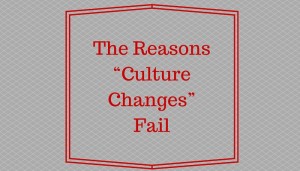 Larry Senn recently published an article that outlines the steps for effective cultural change and talks about the common reasons culture change initiatives fail. He has spent the better part of 40 years studying organizational cultures and what leads to change and therefore performance improvement and what holds it back.
Larry Senn recently published an article that outlines the steps for effective cultural change and talks about the common reasons culture change initiatives fail. He has spent the better part of 40 years studying organizational cultures and what leads to change and therefore performance improvement and what holds it back.
Reason #1
The first reason cultural change does not work is that it’s not led by the CEO. If it’s not purposeful on the part of the leader it’s not going to happen. Most organizations offload “fixing culture” to the HR department, which is rarely, if ever, successful. HR has its role, but effecting a large cultural change is not one of them. My experience in a large organization where the HR Leader took over “culture” created one of the most toxic environments I have ever worked in – so much so that no one, and I mean no one, would ever go to HR for help with issues. Culture change needs to be “on purpose” by the leader and led from the top. Only the CEO or Leader can be the Chief Culture Officer, or as I say in my book, the guardian of the organization’s culture and character.
Reason #2
The second reason Senn cites is that the process does not create deep personal commitment to change, meaning it’s too “heady” or too intellectual. It may dig up a few things with 360s and the like, but no real understanding of what transformational change looks like. We are feeling beings who think, not the other way around and unless there is a profound personal “feeling” reason for the change, it won’t happen. People have to develop new habits and hanging on to the old ones is not only easier but more comfortable. Change is hard and most people want someone else to go first.
Reason #3
The third reason is that it is often a series of disconnected activities, not a cohesive, managed strategy. The monthly or quarterly training, the speakers who are the flavor of the month, none of these activities will lead to lasting change unless they are part of a very coordinated and managed strategy that works to incorporate these tactics into the fabric of the company through systems and processes. Ever heard when people say, “why do we bother with the stuff when nothing ever comes of it?” In fact, sporadic activities are not only ineffective, they can make matters worse.
Reason #4
The last reason is pretty obvious, but you’d be surprised by how often it happens. The strategy is not taken from top to bottom throughout the organization in a way that creates momentum. Cultures are living breathing things, and they keep going whether you like it or not. If the entire organization does not get behind a change, it might end up worse off than the current situation. Just because the HR director or CEO “want” a change, doesn’t mean it’s going to happen. All leaders and employees need to be engaged in the process of change in order to make it a success.
These are four very important items for trying to turn a ship around when it’s headed off course. The other piece in all of this is that a few shipmates may have to be given their walking papers along the way if they no longer fit into the new cultural paradigm
